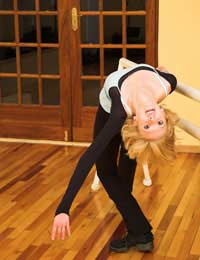Using the Barre

It might seem like a simple warm-up or a set of boring exercises but in fact, the work you do at the ballet barre is the foundation for all the other work you do as a dancer. Barre work not only builds your skills in ballet, but adds to your proficiency in any other kinds of dance that you do. Everything from your strength and balance to your grace and energy can be improved by concentrating your hardest in that first half hour of your weekly ballet class.
Pliés
Barre exercises, as you may by now have noticed, follow a standard progression from slower more basic movements to those with more speed and dynamic. Although the plié is almost always the first barre exercise you’ll do, it is not to be ignored! Pliés are, in fact, one of the most important – if not the most important – exercise you can do. This is because it trains the body in shape and placement.Plié exercises are usually a combination of demi-pliés and grande pliés, so as you bend the knees, you are teaching your hips to turn out, your ankles to resist collapse, your feet to relevé, and your stomach and torso to stay lifted. Though it seems like a simple movement, the plié might be seen as the building block to the rest of your dancing. If you’re doing it incorrectly, chances are those mistakes are carrying over to almost everything else you do. Also, the strength that you build in your thighs and calves during this exercise become your source of power when you turn, jump and leap at centre.
Tendu and Degagé
Tendus and rond de jambes, both of which can be done with or without plié, train your leg and foot to stay elongated and pointed. Side and back tendus in particular help the dancer to maintain turn out even when the leg is in a less than natural position. When doing ballet, jazz, or show dancing, pointing the foot and making the leg look long and strong is extremely important. Degagé, when a tendu leaves the floor, teaches the body to use this skill in turns and jumps, or whenever your feet leave the ground.Grande Battement
These high kicks help strengthen your hamstrings, which are responsible for ‘throwing’ the leg. They also teach you to control the leg coming down, building your quad and abdominal muscles as well. The most dynamic of the barre exercises, battements should also get your blood flowing, warming you up for the rest of the class and readying you to move to the centre of the room.Port de Bras
The port de bras, or ‘carriage of the arms’, that accompanies each barre exercise help make you a more graceful and fluid dancer. When you are concentrating on kicking, bending, and memorising patterns, it can be easy to forget that your arms are even there! However, the more of a workout you give your arms at the barre each week, the more stamina they will have during centre work and in classes like jazz and hip hop.Of course, the very nature of the barre suggests that one arm will probably be holding on (albeit lightly) to give you support and added balance. But the arm that is dancing must be doing just that. Pay careful attention to making your arm movements soft and smooth. Be aware of whether they are following or contrasting the movement of the legs. Often the arms must stay soft while the foot work becomes harder and this coordination can be difficult to master. Building coordination and strength is best done by remembering to dance with the whole body at all times.


Re: Joining A Dance Company Or Dance Group
I love dancing I want to kn more about dance
Re: Joining A Dance Company Or Dance Group
I have a dancing group so I want to compete with other teams
Re: Joining A Dance Company Or Dance Group
hi please I want to join this group because I love dancing but I dont have a group. this will help me to know how to…
Re: Joining A Dance Company Or Dance Group
I know i cant sing,but i can dance,i want it to show my dance to all people who watching
Re: Joining A Dance Company Or Dance Group
I love dancing and I want to know how to dance
Re: Joining A Dance Company Or Dance Group
I love dancing and I want to dance and become a dancer
Re: Joining A Dance Company Or Dance Group
Hello im Krish im doing Dance form 9 or 10 and i want join and earn my form my future and my profession and i can do…
Re: Joining A Dance Company Or Dance Group
I love you all
Re: Joining A Dance Company Or Dance Group
I want to join please get back to me+2347046149932
Re: Joining A Dance Company Or Dance Group
I want to be a part of dance group